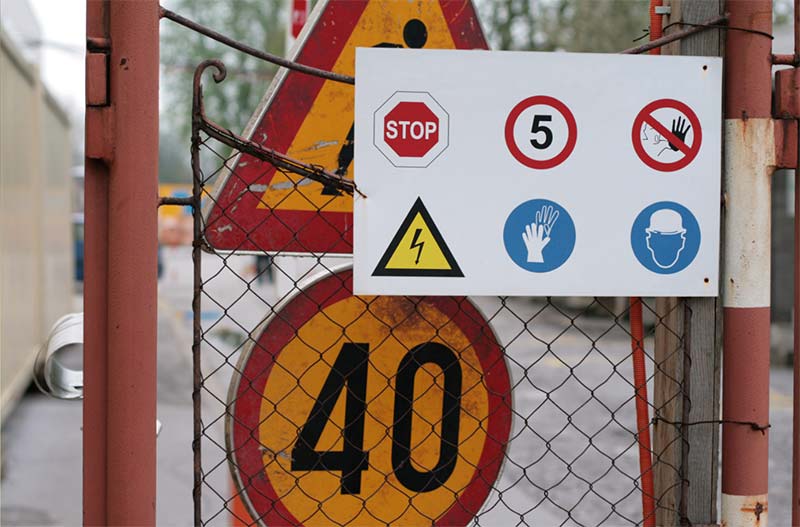Site Signage and Organisation Guide for Construction
Construction sites are extremely busy places. As well as plenty of machinery in action around the site, there will also be company staff, contractors and subcontractors working in various locations. Some will be working at ground level, inside and out, while others may be working at height.
Every construction site must have the necessary site signage and organisation guide. This is to ensure that not only are the company and contractors adhering to the legal requirements, such as Health and Safety, but also to guide those on-site on where to go and who to liaise with.
What site signage is needed for health and safety?
Let's start off with the necessary safety signage on construction sites. Employers must ensure that the area has sufficient safety signage highlighting any potential risks on-site that are to be avoided or controlled. Safe systems of work or engineering controls may also be required under other relevant legislation, or where safety signs won't reduce the level of risk.

However, most construction sites have areas of danger, and in these circumstances, employers are required to:
- Make sure road traffic signs are used to regulate and control road traffic flow
- Maintain all safety signage they have provided throughout the site
- Ensure all employees understand any unfamiliar signs and explain what they need to do when they see the safety signs
The Health & Safety (Safety Signs & Signals) Regulations 1996 requires employers, duty holders and others on construction sites to take responsibility for the control of the workplace and people on site. This includes looking after those who are operating equipment.
Safety signs and signals must be put in place, in addition to other signage, where there is a significant risk to the health and safety of employees and other construction site workers.
It is the employer's responsibility to make sure that the signage is clean and legible at all times without any obstructions blocking the signs. The signs must clearly identify what actions are prohibited, such as no access, and any safeguards that must be followed, like wearing hard hats or ear protection. They should also warn of any hazardous materials, like corrosives, used in an area and direct the person towards the relevant fire exits and any fire or first aid equipment.

However, it's essential to ensure signage on the construction site does not conflict or cause any confusion. There are five types of safety signs required:
- Warning signs, such as work overhead, wet floor, highly flammable, under construction, asbestos and harmful chemicals
- Mandatory signs, including hard hats must be worn, fire door keep shut, wear gloves, high visibility clothing, or safety harness must be worn
- Prohibition signs, like no entry, no parking, no smoking and speed limit
- Safe condition signs, which include fire exit, first aid, spill kit and fire assembly point
- Fire equipment signs, such as fire alarm, fire extinguisher, hydrants and fire blankets
The colours of safety signs are also relevant:
- Red = danger, prohibition, stop, alarm, and you must take action. Fire safety also uses the colour red.
- Yellow/amber = warning, be aware and be careful.
- Blue = mandatory; you must obey or do.
- Green = emergency escape, first aid, no danger, follow to reach safety.
Sometimes it is obvious where the signage needs to be displayed, but it’s crucial to conduct a risk assessment to determine safety sign usage. In some places, there may be several types of signage, such as a warning sign together with a mandatory sign.
What is site organisation?
Without organisation, there is chaos, and you certainly don't want that on a construction site. The HSE details all the various aspects of site organisation, from site rules and welfare down to traffic management and protecting the public.
At the heart of a site organisation plan is the health and safety of employees, contractors, sub-contractors and the general public who may be involved or connected to the construction site.
When drawing up a health and safety site organisation plan, there are seven primary site areas to consider. These are:
- Site rules and induction - guidance on what can and can't be done on the site. It is focused on the health and safety of everyone on-site, as well as how employers can meet their legal requirements. Part of this is ensuring everyone, including a visitor to the site, is taken through a site induction before venturing onto the site.
- Traffic management - whether it's the vehicles moving around the site, those entering and exiting the area, or the traffic outside, it's vital to ensure that they are not a hazard to anyone working on the site or visiting.
- Site lighting - this section details how the site will be lit to ensure workers or visitors are able to see where they are going and what they are working on.
- Protecting the public - these are detailed measures put in place to protect the public on and off-site, such as stopping unauthorised access.
- Materials storage and waste management - this sets out how materials are safely stored on-site, ensuring they don't present any hazards. It also details how the waste is removed and its safe disposal.
- Welfare - this records how employers meet their legal requirements by ensuring the correct welfare facilities are on site, such as providing washing and toilet facilities, rest areas, drinking water and sometimes refreshments, lockers and changing rooms.
- Administration - the last section is all about the relevant paperwork required in order to manage the construction site in accordance with legal rules and safety procedures.
Construction sites can be dangerous places. Every employer in the construction industry must ensure that health and safety guidelines and legal requirements are adhered to at all times to look after the welfare of everyone on site.
At ESE Direct, we have a wide variety of site safety signage that will ensure your construction site is the safest it can be and that the welfare of everyone on site is looked after. As well as our standard red warning signage, like no smoking and no admittance, we also supply traditional site safety signage containing multiple messages so that you know your site is safe. We are experts in providing a wide range of products for businesses. Contact us today.

Author Bio - Debs
Digital marketer, social media, content writer, musician, sloth-lover, tea-drinker.




